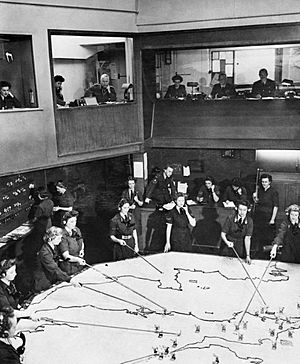Plotter (RAF) facts for kids
Plotters were people who tracked aircraft movements on large maps during World War II. They played a super important part in battles like the Battle of Britain and during The Blitz, when enemy planes bombed British cities. Plotters worked in special rooms called Sector Control Rooms or Group Control Rooms. These rooms helped direct RAF fighter planes. Most plotters were women who were part of the Women's Auxiliary Air Force (WAAFs).
Contents
How Plotting Began: A Look Back at World War I
The idea of plotting started way back in World War I. In 1918, a man named Captain Philip Edward Broadley Fooks had a clever idea. He suggested using a big map in London to show where aircraft were.
Tracking Planes on a Map
This large map had a grid on it, like a giant chessboard. Operators would place small pieces on the map. These pieces showed where planes were flying. They used different shapes and colors to tell if the information was new or old. Operators moved these pieces using long wooden sticks, like a croupier at a casino table. They got their information from people watching in the fields and from special listening devices called acoustic detectors. These detectors could hear planes from far away.
Plotting in World War II: Radar and Observers
By World War II, the control rooms looked a lot like they did in World War I. But the way they got information had changed a lot. Plotting now used reports from new technologies.
New Ways to Spot Aircraft
One big change was the invention of Chain Home radar stations. These stations could detect enemy aircraft as they flew towards the British coast. Another important source of information was the Royal Observer Corps. These were groups of people who watched the skies over land. They spotted both enemy and friendly planes.
From Reports to the Map Table
All these reports went to a special place called a Filter Room. Here, Filter Plotters quickly sorted through tons of information by hand. They made a summary of the most important details. This summary was then sent to the main Operations (Ops) room, which was often underground for safety.
How Plotters Moved the Pieces
Inside the Ops room, many plotters gathered around a huge table. This table had a map of the area on it. Plotters received details about aircraft, such as:
- How many planes there were.
- Their exact location.
- How high they were flying.
- Their direction.
They used special counters to represent the planes. Plotters moved these counters around the map using long plotting rods. These rods could change length and had magnets to pick up the counters easily. Each plotter was in charge of tracking planes in a specific area. They constantly updated the positions of the counters. This way, controllers could see the full picture of an air raid from a viewing gallery above the table.
See also


